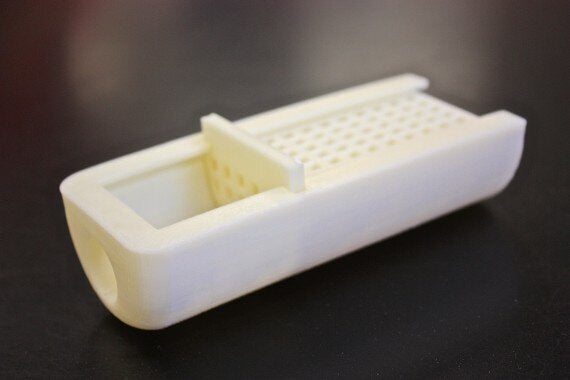
A 3D model of filtration system created by Ontario high school students. (Photo: Maham Abedi/HuffPost Canada)
It’s a plastic prototype small enough to fit in your hands.
But its potential is huge. A model created by Canadian students could help clean up the world’s largest body of freshwater.
The Great Lakes are polluted with innumerable microbeads, miniscule pieces of plastic most commonly found in hygiene products such as toothpastes, face washes and body scrubs. The plastic beads are meant to exfoliate skin, but many experts say natural ingredients such as ground walnut shells and rice work just as well.
At just half a millimetre, they’re too small to be picked up by most filtration systems, and so they enter bodies of water around the world.
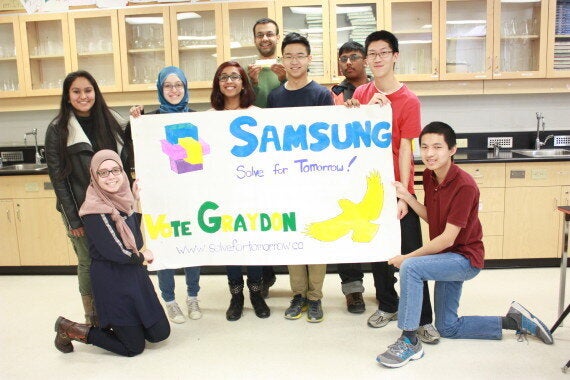
Mississauga, Ont. high school students hope their filtration concept will win them the Samsung Solve for Tomorrow competition. (Photo: Maham Abedi/HuffPost Canada)
Nine Grade 11 and 12 students at Gordon Graydon Memorial Secondary School in Mississauga, Ont. are working on a world-changing solution. They’ve spent seven months designing a filtration system they think would catch mircobeads before they enter the water.
After weeks of research, strict deadlines, and meetings with environmental groups and politicians, the group created their first model. A few revisions later, this is what they came up with:
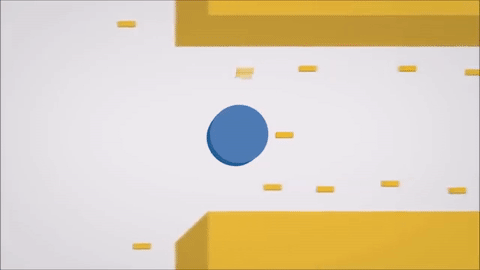
An animation created by students shows their concept in action.
It’s a half-pipe, divided with one vertical and one horizontal grid, that would be placed at the end of existing sewage filtration systems.
Water would flow through the half-pipe after larger waste has already been filtered out.
Microbeads and other microplastics not caught by existing systems would be negatively charged using electricity as they pass through the vertical grid inside the pipe.
The second horizontal grid would have a positive charge and sit slightly above water level. The opposite charges would attract the microbeads upwards and hold them. This would keep the beads from flowing into the lakes along with water.
The second portion would be detachable, allowing companies to clean and replace it after it fills up with waste.
“We didn’t actually make this on the fly,” Mickey Dang, a student in the project, told The Huffington Post Canada. “As high school students, I think it’s a good idea that you apply what already exists.”
Dang explained that a similar method is used in some factories to electrically charge smoke pollution, as a way of moving it around and improving air quality.
Over time, the addition of the half-pipe to sewage systems could rid lakes of the existing microbeads pollution.
“It won’t immediately filter all the microbeads out, but when that water comes back to your faucet and it runs through the cycle a couple times, eventually in a couple of months it’ll come to a point where you’ve filtered it out,” student Haider Rahmani explained.
“The solution proposed by the students is innovative and deserves to be tried out under real-world conditions.”
— Philippe Van Cappellen, professor
While the students’ idea is still in its early phases, it certainly has drawn attention.
In March, they became one of 11 finalists in the Canada-wide Samsung Solve for Tomorrow competition and won $20,000. Now the group is trying to snatch one of the competition’s two top prizes of $50,000. If they win, they’ll also get a chance to be featured on the popular YouTube channel AsapSCIENCE.
Their idea has also garnered the interest of academics.
“I think it is a wonderful project,” said Philippe Van Cappellen, a professor at Ontario’s University of Waterloo, who studies the impact of plastics in the Great Lakes.
“The solution proposed by the students is innovative and deserves to be tried out under real-world conditions,” Van Cappellen wrote in an email to HuffPost Canada.
#BanTheBead Movement
The group’s invention comes as a movement dubbed Ban the Bead is flourishing around the globe.
Several countries have already moved to ban microbeads. In December, U.S. President Barack Obama signed a law prohibiting their manufacture as of July 2017, and banning the sale of cosmetic products that contain microbeads by July 2018.
The Canadian government is working on similar legislation, and wrapped up public consultations on the issue last month.
The federal government intends to stop the manufacture and import of “microbead-containing personal care products” by December 2017, and phase out sales by the end of 2019.
As a result of incoming bans and public outcry, several companies such as Johnson & Johnson’s, The Body Shop and L' Oréal have also pledged to stop using plastics in their products.
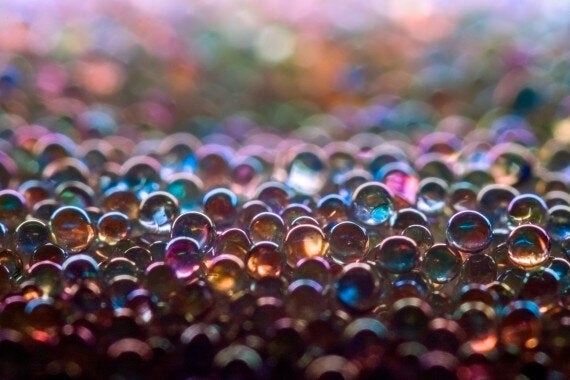
Microbeads found in the Great Lakes are often mistaken for food by wildlife. (Photo: Getty)
Much of the public outcry around the issue is due to environmental concerns raised by studies in recent years.
A 2013 report found as many as 1.1 million microplastics per sq. km. in Lake Ontario. A year earlier, another study found 460,000 microplastics per sq. km. in Lake Erie.
The studies noted that most of the microplastics were round and likely came from cosmetic products.
Jennifer Caddick, who works with environmental advocacy group Alliance for the Great Lakes, says the pollution caused by microbeads is particularly harmful to wildlife.
“Animals, particularly fish and sometimes birds, mistake them for food,” Caddick told HuffPost Canada, explaining that microbeads also attract other waste and chemicals floating in the water before being ingested by wildlife.
“Plastic pollution in our waterways is going to continue to be a problem for a long time.”
— Jennifer Caddick, environmental advocate
While the movement to ban beads gains momentum, Caddick says a filtration system like the one the Ontario students have engineered is still needed.
“We forget just how much of what we use on a daily basis is plastic. Plastic pollution in our waterways is going to continue to be a problem for a long time,” she said.
She added the solution lies in a mixture of both reducing plastic consumption, and looking at improving sewage systems.
The idea behind the filtration system may seem promising, but without proper funding it’s unlikely the students themselves will be able to take it much further.
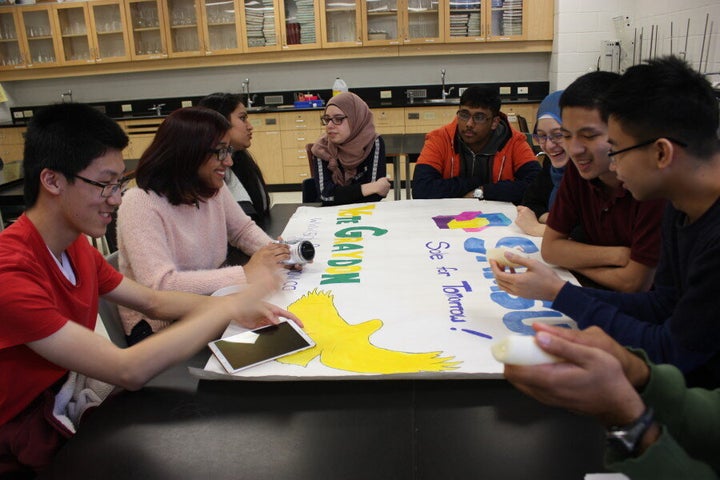
The team at Gordon Graydon Memorial Secondary School is hoping to win a $50,000 prize from Samsung. (Photo: Maham Abedi/HuffPost Canada)
For now, the group is eyeing the $50,000 prize and the acclaim it will bring. But the money will go to the school, explained teacher Marina Petrychkovych who has been overseeing the project.
“It’s not necessarily being tested in any way, however, maybe people out there are listening, because sometimes the simplest, most innovative things come from students, or even one individual. And that becomes revolutionized,” Petrychkovych said.
Many of the students involved are set to graduate this year, but they say they’ll continue to raise awareness about plastic pollution.
“Our biggest idea was spreading awareness,” says Dang, but he hopes the project will some day take form, regardless of who takes it on.
“It’s a large-scale project and we can’t put it there ourselves,” he says. “This is a concept idea, but it has a foundation to it. Pursue it.”
Also on HuffPost:
